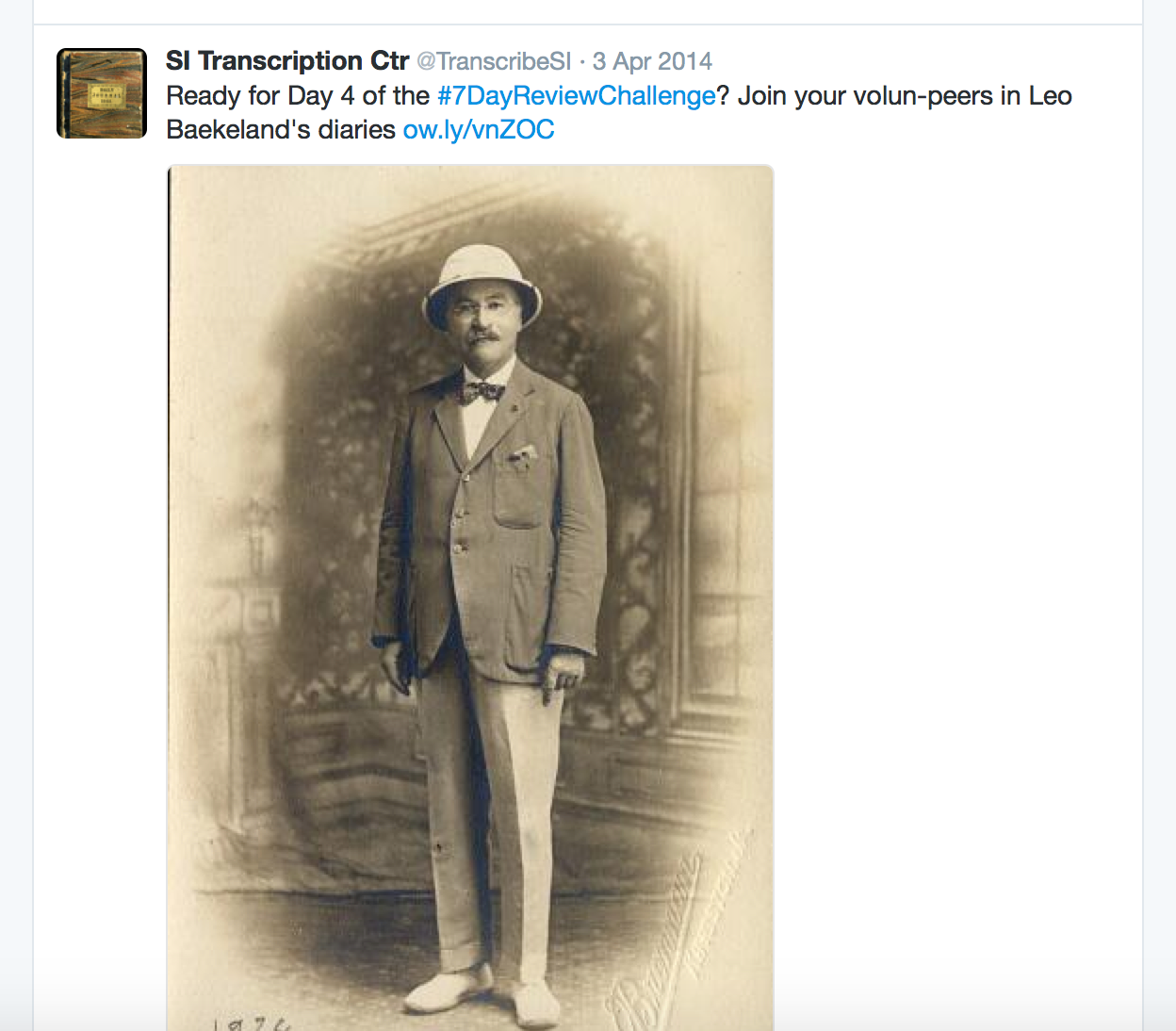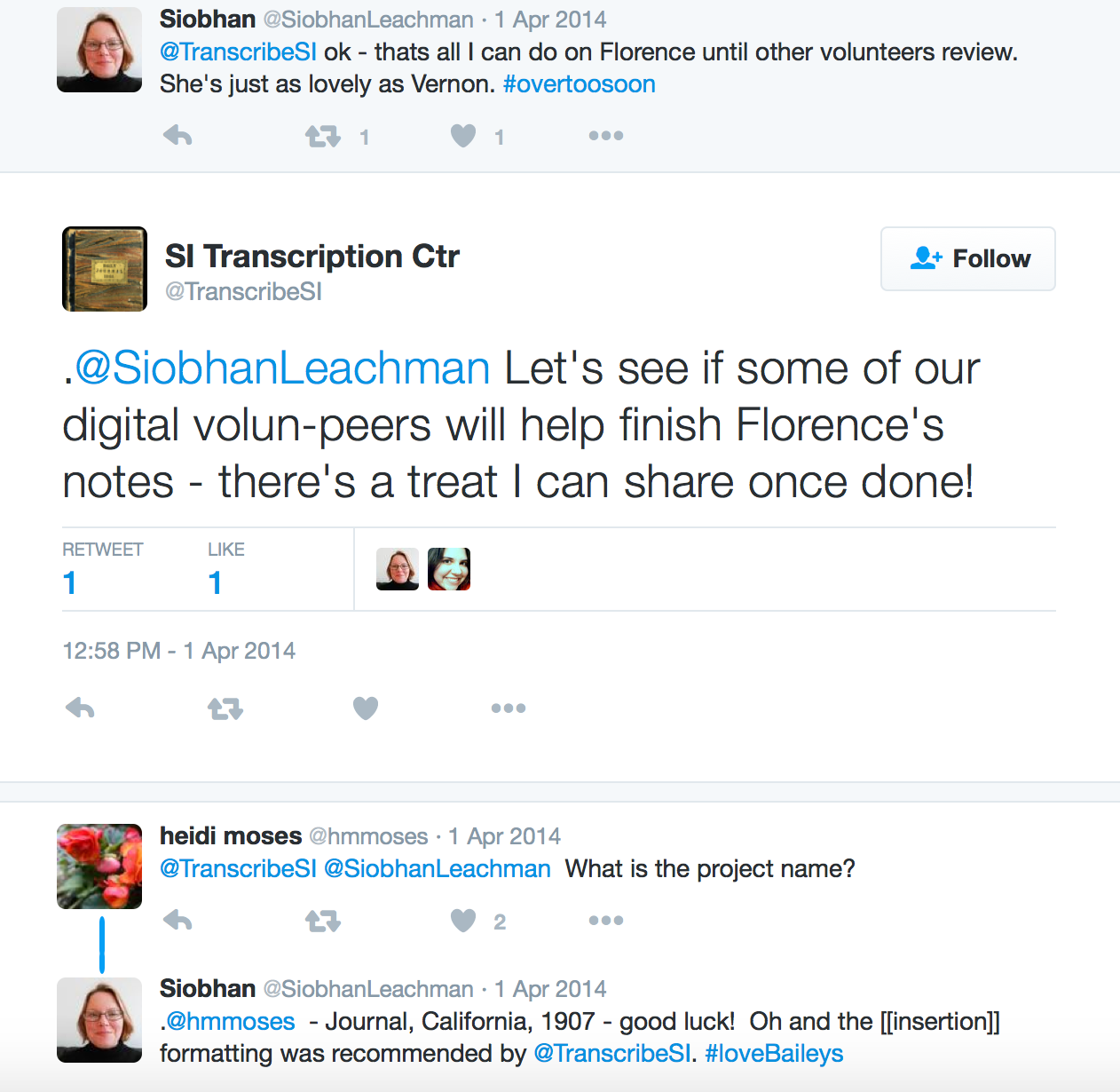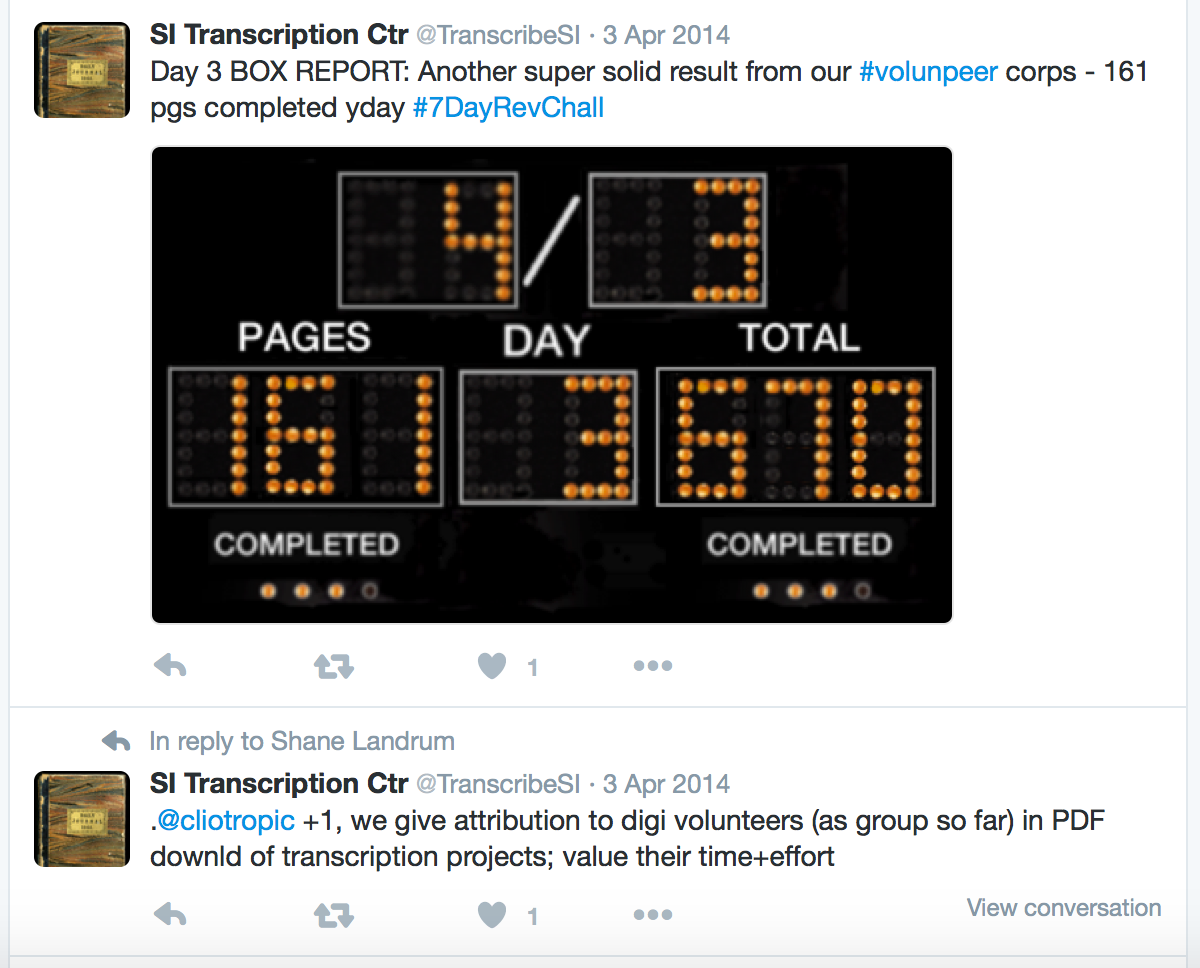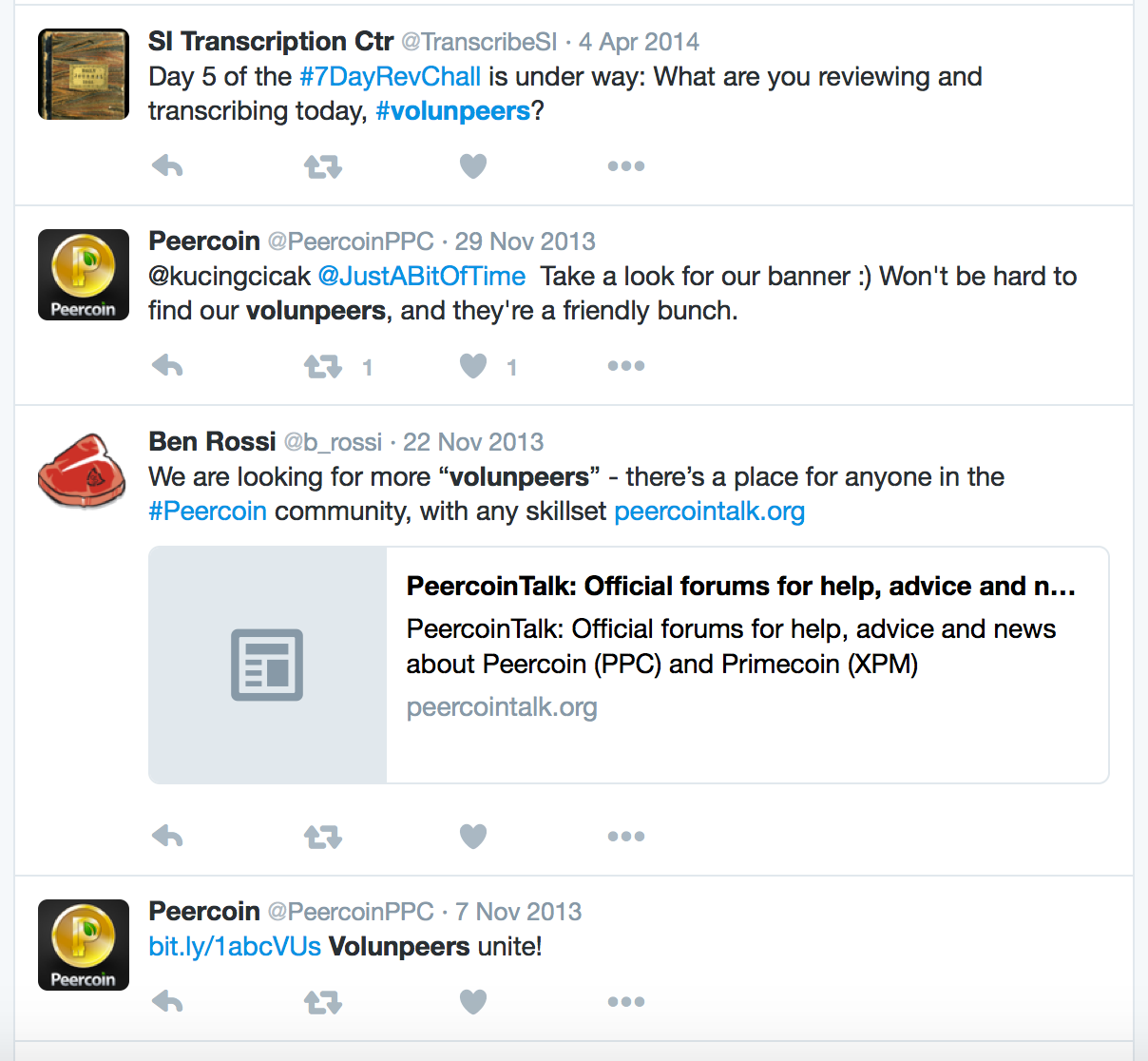Category: Memory
Volunpeers: Hashtag, Identity, & Collaborative Engagement

“Volunpeers” is a flexible term for volunteers, organizations, and institutions to succinctly represent the knowledge-building activities and collaborative enterprise in which they are engaged. When used as a hashtag, #volunpeers can be leveraged to quickly connect individuals to asynchronous collaborative activity. It is a term that may be used to draw novice volunteers into public discussion about crowdsourcing and citizen science activities, as well. It also may be used as a way to announce discoveries and call out for help. “Volunpeers” specifically challenges heirarchical, as well as the exclusivity of, knowledge production and the efforts to created that knowledge; as part of a wider set of activities, it is a term and an identity that may be affiliated with the promise of digital technologies, the internet, and the democratization of knowledge. It is also an identity adopted by participating volunteers to describe themselves and their positioning with this crowdsourcing project of the Smithsonian Transcription Center. This post describes the ways I first implemented the term in coordination with the activities of Smithsonian’s Digital Volunteers and the Smithsonian Transcription Center in April 2014 and its continued use today.
I was several months into my role as project coordinator for the Smithsonian Transcription Center in April 2014, plus a day or two into our second TC 7 Day Review Challenge. I’d issued a goal of reviewing–and ideally completing–as many pages as possible in 7 Days. It was an open, but still formidable task.
Digital volunteers at this point tended to communicate directly with the Transcription Center (i.e. me) via feedback e-mails and tweets. The TC did not and still does not have a discussion board. One drawback of this design decision: some kind of work-around might be necessary when volunteers wanted to bounce ideas or ask others to join them on challenging projects. However, it is also a design decision that creates alternative opportunities for communication between participants – specifically in the social media spaces in which they may already operate.
While responding to a volunteer’s tweets on 01 April 2014 using the @TranscribeSI Twitter handle, I suggested another “volun-peer” might be able to help. In the first 2 days of using these 9 characters, I swiftly incorporated the term “volun-peer”, then “volunpeer”, then the hashtag #volunpeers into the rhetorical approach and central mindset of the TC in three key ways.
In the first use of the hyphenated term, I’m suggesting a portmanteau to blend of meaning of volunteer and peer. This implicitly rejects a hierarchy of volunteers and highlights the peer review and collaboration of the TC.
In the second use, I’m still applying a hyphen but signalling members of the group to an unknown wider set of members while setting out a call-to-action.
In the third use, I continue to use the hyphenated term and this time attempt to catalyze a call to action focused around content: a dapper Leo Baekeland and his diaries.
I actually start using a hashtag and non-hyphenated term in the fourth use of volunpeers on 03 April 2014. This first time the hashtag term is singular: #volunpeer. I used it in this way to share the collective contributions of all volunteers engaging with the 7 Day Review Challenge.
Finally, in the 5th use of the term the next day, I use the plural hashtag. In this case, I’m asking questions and trying to generate genuine discussion using this hashtag.
By the 6th, 7th, and 8th uses, the hashtag is allowing me to attach to it messages of encouragement, questions, and report outs. This Grand Total summary below is my 7th use of the term “volunpeers”.
I’m also able by 07 April 2014 to leverage the structural capacity it affords and its discoverability as a hashtag (c.f. Mechant & De Marez, 2012).
In a forthcoming article in a volume of COLLECTIONS: A Journal for Museums and Archives professionals, I describe the ways a hashtag can be a useful string of characters, plus so much more. Specifically, as a hashtag, #volunpeers is employed as a vehicle for conveying information through a social network to the eyes of other willing and interested volunteers.
To summarize myself: the term #volunpeers moves beyond an ascribed label to an adopted identity for those who feel affinity toward its meanings. It also actively incorporates collaborative construction of knowledge. Using #volunpeers chips at barriers and hierarchies of authority between an institution and public through on-going interaction. Staff are learning and improving their workflows through interaction with the public, as well. Rather than telling and directing, #volunpeers can be deployed by the public as well as staff as a means of sharing and inviting productive discussion and inclusion with their work. I use the term to signify the boundaries and the ways they might be blurring, as with collaborative space that uses peer review; and to honor what is possible together rather than what is being done by individuals.
I should note that while @TranscribeSI was the first to use the hashtag #volunpeers, it was used several times in 2013 by a PeerCoin community; and specifically to signal knowledge exchange!
So, what do you make of “volunpeers”? What does it mean to you? Do you think #volunpeers is appropriate, ambitious, or too conservative for crowdsourcing and citizen sceince? Do you consider yourself a volunpeer and if so, why?
Mechant, Peter, and Lieven De Marez. 2012. “Studying Web 2.0 Interactivity: A Research Framework and Two Case Studies.” International Journal of Interactive Communication Systems and Technologies (IJICST) 2, no. 2: 1-18.
RDR on 10 Distinctive Qualities of Qualitative Research
Research Design Review recently summarized 10 distinctive qualities of qualitative research which succinctly capture the essence and utility of the kind of work performed by researchers like me.
In her Research Design Review piece, author Margaret Roller observes that qualitative research happens because researchers “acknowledge the human condition and want to learn more, and think differently, about a research issue than what is usual from mostly numerical quantitative survey research data.”
Below are Roller’s 10 attributes (in bold) and the reasons I consider them useful.
- Absence of “truth”
- As suggested on this blog regularly, knowledge is constructed from information and in context. It is the the product of the process of research; it is not truth but rather “possibility” (plausible interpretation). I often describe my findings or interpretations as “ONE truth” or “one version of truth/reality,” emphasizing that my interpretation is well-informed but always subject to negotiation based on further context
- Importance of context
- The setting, culture, research parameters and questions always influence the ways in which we can interpret data.
- Importance of meaning
- Meaning is created through understanding the blooms from the intersections of many points in analysis. Roller suggests sources for meaning include “any number of variables such as: the context, the language, the impact of the participant-researcher relationship, the potential for participant bias, and the potential for researcher bias.”
- Researcher-as-instrument
- The interpretations and the process of research are performed through and organized by and described through the researcher. This has many benefits including the potential for nuanced findings and “thick description” but it is also important to consider the bias, approaches, and institutional contexts of the researcher – as well as the power the researcher wields as an instrument of qualitative analysis. Remember, many choices, and therefore the exercise of power, play a role in final interpretations.
- Participant-researcher relationship
- This is element of qualitative research is extremely important in performing and getting useful and accurate interpretations. Communication, rapport, and accountability all play a role in a successful participant-researcher relationship and shape the outcomes of data collection and analysis.
- Skill set required of the researcher
- Perhaps the most underrated of these qualities, qualitative research “requires a unique set of skills from the researcher, skills that go beyond the usual qualities of organization, attention to detail, and analytical abilities that are necessary for all researchers,” Roller observes. She goes on to list rapport-building and active listening as further examples, but her most notable point is that specific and nuanced analytical toolkit is necessary to “meet the demands of “messy analysis” (see below) in qualitative inquiry where context, social interaction, and numerous other inter-connected variables contribute to the realities researchers take away from the field.” This is often the most difficult thing to explain when entering a project but often unfolds without stakeholders realizing. If it’s a smooth researching process with audiences, you’ve likely brought on board a skilled researcher.
- Flexibility of the research design
- Again, an extremely complicated skill to bullet point on a resume. Yet, a flexible researcher knows how to stay active and continue to derive communication while simultaneously analysing the information; second and third passes over the data will allow for even more robust findings. In other words, the intended questions may be set aside to capture the reality of the researching space and research may take iterations to flesh out hidden meanings and perspectives.
- Types of issues or questions effectively addressed by qualitative research
- Especially for questions that really mean “to what extent” rather than “how much” or seeking to understand group behaviors and cultural values that emerge concurrently with or contradict official/dominant perspectives.
- Messy analysis and inductive approach
- Qualitative research may start with a general question and create understanding as knowledge is being attained. Roller writes “without a doubt, qualitative research analysis is messy. The analysis of qualitative data does not follow a straight line, where point ‘A’ leads to point ‘B’, but rather is a multi-layered, involved process that continually builds upon itself until a meaningful and verifiable interpretation is achieved. The messiness of the interconnections, inconsistencies, and seemingly illogical input reaped in qualitative research demand that researchers embrace the tangles of their data from many sources. A large contributor to the “messiness” of the analytical process is the inductive method. Qualitative researchers analyze their outcomes from the inside out, organizing and deriving meaning from the data by way of the data itself.“
- Unique capabilities of online and mobile qualitative research
- Finally, technology allows for new techniques AND new research spaces – and supports general communication and connection (and conflict!) between groups of people. The resulting research space, as Roller suggests, offers new power dynamics between researcher and participants but also offers shared control of findings and more flexible ways to gather, respond, organize and distribute research findings.
Qualitative research is excellent for unlocking detailed case studies, understanding communication and communities, and understanding audiences and every day lives, as well as helping flush out and answer the assumptions and further questions that often emerge in quantitative analyses.
Doing it well: Communication and Discourse work in the fandom

In this post, I summarize specific actions and communication in a fandom in a social networking space, focusing on how discourse work can be seen in their daily activities. This post shifts focus from my recent posts relating to my work in cultural heritage in digital spaces to draw out parts of my ongoing research in the US Women’s soccer team (USWNT) Tumblr fandom.
As alluded to on my landing page, I have been conducting an ethnographic, or netnographic (Kozinets, 2009), study within the social networking and microblogging site Tumblr for the last two years. I perceive Tumblr to be a unique digital space that allows individuals to “opt in” to a community of practice – one that integrates discourses of women’s sport and soccer, media, competition and nationalism, notions of gender and sexuality, and narratives of the USWNT in daily discussions.
When individuals in the USWNT fandom share, consume, and create content, they encourage a shared group affiliation (as “fans”). Their communication occurs in a flexible, asynchronous social realm. Through choices in language, timing, media, and “tone” these fans establish a series of temporary discursive spaces to explore, express, and discuss their feelings.
Communication within the wider USWNT “fandom” project
- actively teaches new users,
- rewards insider knowledges,
- allows for dissension and discussion, and
- offers opportunities for inclusion of fans, who might otherwise be isolated from fan activity
Tumblr’s structure also facilitates distinct techniques of self-expression and specific language selections shared through tags, asynchronous communication, “reblogging,” and “asks.” Fandom activity includes discourse work and content creation.
On Tumblr, USWNT fans do the following*:
- make text post updates from official US Soccer sources
- post original text posts stating feelings or opinions on the team’s performance
- post original text posts stating feelings or opinions about other people/fans in the fandom
- make and answer anonymous questions using the “Ask” feature on Tumblr
- share social media content from players – typically tweets and Instagram pictures
- share images from USWNT training sessions and games
- share images from NWSL training sessions and games
- create GIFs of moments from games
- create GIFs of informal moments from US Soccer official sources (regenerating and reworking discourse)
- create specialized graphical representations with images
- request and provide links – livestreams, presentations, videos
- request GIFs, videos, and other information from other users
- tag posts – categorizing and allowing content to be searched
- police use of the tags – specifically the tag “USWNT” – by messaging and posting “rules” of tagging
- ask for input and opinions on apparel, ticket purchases, game etiquette and moe
- discuss the fandom and their feelings of inclusion and participation in that community
As a part of this study, it has become clear that not only is the USWNT fandom shaped by a number of resources and communication practices – and there are also differences in fandom activities at different times. For example, in February, I compared the variations in language choices some fans make during a game – or when they are “livetumbling” – and in their daily circulation of posts and reblogs.
In reblogging posts, users are clearly making decisions about which components of public meaning and insider knowledge they would like to perpetuate. When a user likes or reblogs a post about Alex Morgan but ignores another post about Amy Rodriguez, they are marking out the space and value of pieces of knowledge for the fandom.
What the USWNT fandom actually discusses and creates are representations of the USWNT, players, other fans, opponents, and other popular culture narratives. As with making knowledge, representations are devised through making choices, where fans work with discourse and other cultural materials from which interpretations may be made. Mediated sport discourse, as well as USWNT fandom Tumblr disourses, provide accounts; neither reality nor clean interpretation of events. Rather, as with discourses of mediated sport, Tumblr discourses present a version of events that speaks to broader social relationships and understandings of sexuality, national identities, gender, and imply relationships of power.
Watch this space for further discussion of the implications of these strategic communication choices in the USWNT fandom.
*This is an on-going and developing list, and certainly not exhaustive at this point!
US Holocaust Museum & crowdsourcing displaced children identities

Today is Yom HaShoah or Holocaust Remembrance Day, part of the Days of Remembrance 07-14 April.
You can help the US Holocaust Memorial Museum further identify displaced children of the Holocaust. This is a remarkable project that calls upon the power of crowdsourcing and (re)defining lost pasts through shared memory.
Here are details for the Remember Me? project:
If you recognize yourself or someone you know in one of the photos, please contact the Museum’s Holocaust Survivors and Victims Resource Center at RememberMe@ushmm.org or via phone at 202-488-0416.
The most recently updated profile of Fischer Kampel suggests that memories of these experiences offer comfort to families, too. Kampel’s example underscores the ways in which understanding the experiences of these children helps wider understanding of the role of the Holocaust experience in adult life; and also the ways survivors communicated or were unable to communicate the horrors to their families.
More images and names here and further details about the Remember Me? Project available here – and see @HolocaustMuseum Twitter feed for events and to learn more.






